Land Invertebrates
Media

Species Types
Scientific Name
Various species in the order Pseudoscorpionida
Description
Pseudoscorpions are unusual little arachnids. They look something like tiny scorpions but with a rounded (and nonvenomous) hind end. They're common but often overlooked.
Media

Species Types
Scientific Name
Mecaphesa spp. and Misumessus spp.
Description
Foliage flower spiders are two genera of crab spiders. They are generally smaller than other crab spiders, and their carapaces, abdomens, and legs are spiny.
Media
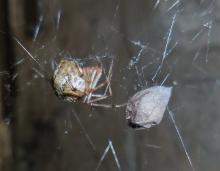
Species Types
Scientific Name
Parasteatoda tepidariorum (syn. Achaeranea tepidariorum)
Description
You probably have at least a few common house spiders in your garage. Take heart: they are harmless and they eat many pest insects.
Media

Species Types
Scientific Name
More than 900 species in North America north of Mexico
Description
Millipedes, which have two pairs of legs per body segment, are harmless detritus-eaters, move slowly, and curl up defensively when harassed.
Media
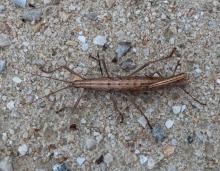
Species Types
Scientific Name
Anisomorpha ferruginea
Description
Be careful when approaching northern two-striped walkingsticks: They can squirt an acrid fluid at you. Musk mare, devil’s riding horse, and prairie alligator are all names for this remarkable stick insect.
Media

Species Types
Scientific Name
Loxosceles reclusa
Description
The brown recluse is a spider whose venomous bite may be medically significant to humans, though a bite is almost never fatal. Brown recluses are most commonly encountered in houses, where they occupy little-used drawers, closets, and other small hiding spaces.
Media
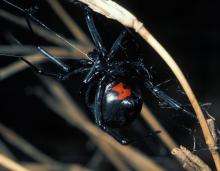
Species Types
Scientific Name
Latrodectus mactans and Latrodectus variolus
Description
The glossy, black-bodied female black widow spider has distinctive red spots on the underside of the abdomen. Only the female can inflict a potentially dangerous bite. The small, seldom-seen male is harmless.
Media

Species Types
Scientific Name
Nearly 250 species in North America north of Mexico
Description
A wolf spider doesn't spin webs to catch its prey — it runs it down like a wolf! Spiders in this family have long legs and are usually gray, brown, black, or tan with dark brown or black body markings (especially stripes).
Media
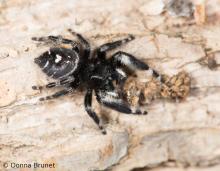
Species Types
Scientific Name
Phidippus audax
Description
The bold jumper, or white-spotted jumping spider, is fuzzy, makes jerky movements, jumps surprisingly long distances, and doesn't build webs. It usually has a black body with white, orange, or reddish spots on the abdomen.
Media
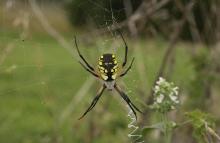
Species Types
Scientific Name
Argiope aurantia
Description
The black-and-yellow garden spider is large but harmless. It sets up large, circular webs in gardens and grasslands. Lucky gardeners can host this remarkable pest exterminator all season long.
See Also



Media

Species Types
Scientific Name
Cisseps fulvicollis
Description
The yellow-collared scape moth is more often “orange-collared.” And whether you think it looks more like a firefly or a wasp, it’s still a moth!
Media

Species Types
Scientific Name
Nearly 150 species in North America north of Mexico
Description
Slim, delicate plume moths are instantly recognizable by their T-shaped silhouette, long legs, and muted shades of tan and brown. It can be hard to separate the various species.
Media

Species Types
Scientific Name
Pyrrharctia isabella
Description
Not many people know the adult Isabella tiger moth when they see one, but we’re all acquainted with its caterpillar, the woolly worm, or woolly bear.
About Land Invertebrates in Missouri
Invertebrates are animals without backbones, including earthworms, slugs, snails, and arthropods. Arthropods—invertebrates with “jointed legs” — are a group of invertebrates that includes crayfish, shrimp, millipedes, centipedes, mites, spiders, and insects. There may be as many as 10 million species of insects alive on earth today, and they probably constitute more than 90 percent all animal species.





















